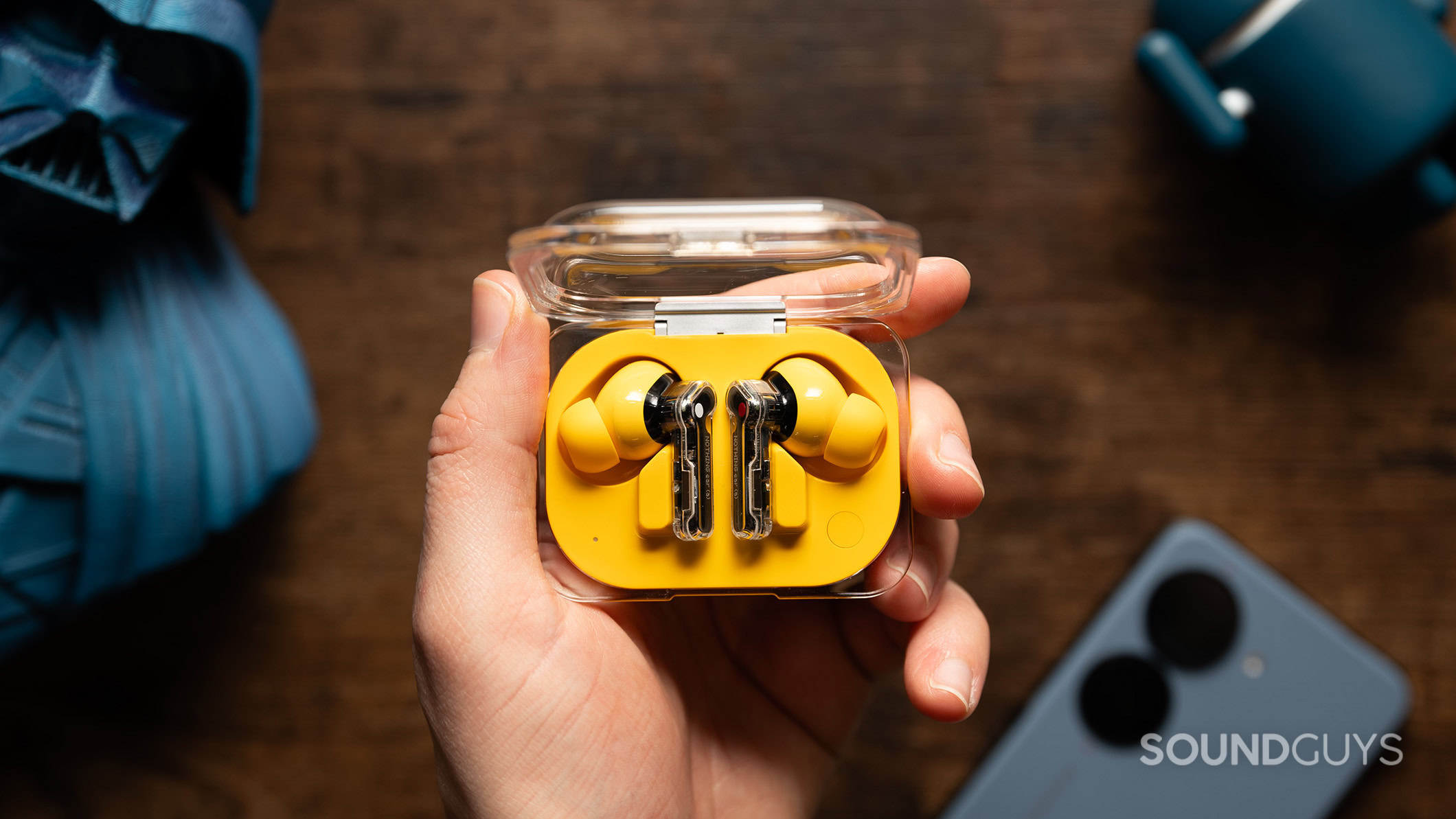All products featured are independently chosen by us. However, SoundGuys may receive a commission on orders placed through its retail links. See our ethics statement.
Nothing Ear vs Nothing Ear (2): Should you upgrade?
Published onApril 3, 2025



After releasing the Nothing Ear (1) and Nothing Ear (2), one would expect the third-generation earbuds to be aptly named “(3),” but instead, Nothing has taken the unconventional approach of simply calling their latest earbuds the “Nothing Ear.” One wonders what the fourth iteration will be called. Odd naming aside, how do these new buds compare to the previous Nothing Ear (2), and are they worth the upgrade? Let’s take a listen.
Editor’s note: this article was updated on April 3, 2025, to update our measurement charts and add more relevant information.
What’s it like to use the Nothing Ear compared to the Nothing Ear (2)?
The Nothing Ear retains the same lightweight, comfortable, and eye-catching transparent design as the Nothing Ear (2). At just 4.6g per bud with a stem design, the Ear is extremely comfortable to wear for long periods, while the Ear (2) is nearly as light at 4.5g.
With an IP54 rating for the buds and IP55 for the case, both the Ear and Ear (2) are well-equipped to handle daily use, including workouts. The cases are compact enough to slip into a pocket, making them easy to take on the go.
While the stems on the Ear (2) could sometimes get in the way of glasses or ear lobes, the Ear’s stem design seems slightly more ergonomic and out of the way. Overall, both provide a great day-to-day usage experience, with the new Ear eking out a small lead.
How do you control the Nothing Ear and Nothing Ear (2)?
Both the Nothing Ear and Ear (2) use pressure-sensitive stems for pinch controls rather than touch panels. The control schemes are customizable but very similar by default, with options like play/pause, skip tracks, and cycle noise canceling modes. The Ear (2) controls were sometimes unresponsive, but thankfully, the new Ear model has improved responsiveness.
Nothing Ear controls
| Left earbud | Right earbud | |
|---|---|---|
Single pinch | Left earbud Play/pause, answer/end call | Right earbud Play/pause, answer/end call |
Double pinch | Left earbud Skip forward, decline call | Right earbud Skip forward, decline call |
Triple pinch | Left earbud Skip back | Right earbud Skip back |
Pinch and hold | Left earbud Noise control | Right earbud Noise control |
Nothing Ear (2) controls
| ACTION | Left earbud | Right earbud |
|---|---|---|
| ACTION One pinch | Left earbud Play / pause Answer phone call / end call | Right earbud Play / pause Answer phone call / end call |
| ACTION Two pinches | Left earbud Next track Decline incoming call | Right earbud Next track Decline incoming call |
| ACTION Three pinches | Left earbud Skip to previous track | Right earbud Skip to previous track |
| ACTION One pinch and hold | Left earbud ANC on / transparency mode | Right earbud ANC on / transparency mode |
| ACTION Two pinches and hold | Left earbud Unassigned | Right earbud Unassigned |
Should you use the apps of either Nothing Ear or Nothing Ear (2)?
Yes, the Nothing X app works with both models and provides useful features. The Ear (2) app has an equalizer, personalized sound profiles, and ANC customization. The new Ear’s app adds an advanced parametric EQ for audiophiles and a partnership with Mimi Hearing for its sound personalization. Both are feature-rich companion apps worth using.
How do the Nothing Ear and Nothing Ear (2) connect?
The Nothing Ear uses Bluetooth 5.3 compared to 5.2 on the Ear (2). This future-proofs it for upcoming tech like Auracast. More notably, the Ear supports both LDAC and LHDC high-quality codecs, while the Ear (2) only has LHDC. However, iPhone users are still limited to AAC and SBC on both. The new Ear adds useful features like Bluetooth multipoint and a low-latency gaming mode to boot.
Is battery life better on the Nothing Ear or Nothing Ear (2)?
In our testing, the new Nothing Ear lasted over 8 hours compared to around 6 hours on the Ear (2). Both cases hold a few additional charges for a total of around 30-40 hours. They support both wireless charging and fast charging via USB-C.
Do the Nothing Ear or Nothing Ear (2) block noise better?
Loading chart ...
Neither model has class-leading ANC, but the new Ear appears to be an improvement. It provides up to 30 dB of total noise attenuation, while the Ear (2) struggled to hit its advertised 40 dB. Overall, both earbuds will reduce the perceived loudness of outside noise by about 70%. However, it’s worth noting that the Ear’s ANC automatically adjusts for fit and environmental noise, which the Ear (2) does not.
Loading chart ...
Both earbuds also have transparency modes that sound quite natural when in use.
Do the Nothing Ear sound better than the Nothing Ear (2)?
The Nothing Ear delivers a significant upgrade in sound quality over the Nothing Ear (2). The new 11mm drivers with ceramic diaphragms provide improved clarity, separation, and soundstage that surpass the Ear (2)’s capabilities. The Ear also avoids the overly trebly default tuning of the Ear (2) in favor of a slightly elevated but more balanced bass response.
Loading chart ...
Looking at the frequency response charts, the Nothing Ear has a more neutral sound signature compared to the Ear (2). The Ear (2) has a significant drop in the mids around 470Hz and a sharp peak in the treble at 5.5kHz, leading to a somewhat thin and harsh sound. The Ear, on the other hand, maintains better balance across the frequency spectrum, with a gentler bass boost and smoother treble.
In practice, this means the Nothing Ear delivers a more detailed and immersive listening experience. Instruments and vocals sound distinct and well-placed in the mix, whereas the Ear (2) can struggle with congestion and sibilance. The Ear’s bass is present but not overpowering, adding weight to the sound without muddying the mids.
Do the Nothing Ear or Nothing Ear (2) have a better microphone?
While neither will provide studio-quality voice capture, the Nothing Ear’s upgraded 3-mic array and AI noise suppression algorithm seem to provide clearer calls with less background noise than the Ear (2) based on our demos. Callers should be able to hear you clearly in most environments with the Ear.
Nothing Ear microphone demo (Ideal conditions):
Nothing Ear (2) microphone demo (Ideal conditions):
Nothing Ear microphone demo (Street conditions):
Nothing Ear (2) microphone demo (Street conditions):
Nothing Ear vs Nothing Ear (2): Price and availability
Both the Nothing Ear and Ear (2) retail for the same price of $149. The Ear (2) may see discounts as the new model hits shelves, but the Ear provides meaningfully better performance for the same MSRP.
Should you get the Nothing Ear or Nothing Ear (2)?
For most people, the new Nothing Ear is the better buy. It improves on the Ear (2) in key areas like sound quality, ANC performance, battery life, Bluetooth codec support, and app customization. The comfort and durability are similar, but the Ear feels slightly more ergonomic. Audiophiles, in particular, will appreciate the advanced EQ and wider soundstage of the Ear.
Budget-conscious buyers who spot the Ear (2) on sale may be tempted, as it’s still a very capable set of buds. But at the same $149 price, the Ear’s overall upgrades make it worth the investment.
The new Nothing Ear takes the crown.
iPhone users miss out on the Ear’s new Hi-Res Bluetooth codecs, so they have less reason to upgrade if the Ear (2) already serves them well. And if you’re especially sensitive to in-ear pressure from ANC modes, neither the Ear nor Ear (2) are ideal choices.
But for Android users looking for premium features and sound without a premium price tag, the Nothing Ear is one of the most compelling options on the market. It outperforms the Ear (2) to earn its place as Nothing’s new flagship earbud.
How do they compare to the Nothing Ear (a)?

If you’re looking to save some cash and are willing to sacrifice a few features, the Nothing Ear (a) is also worth considering. At $99, it’s $50 cheaper than the Ear and Ear (2). You still get the eye-catching transparent design (plus new color options), comfortable fit, ANC, and decent sound quality. However, the ANC performance isn’t quite as strong as the pricier models. You also miss out on wireless charging and some of the app features, like the advanced EQ. The Ear (a)’s charging case durability is slightly downgraded as well. But for more casual listeners who prioritize style, comfort, and affordability over premium features and sound, the Ear (a) remains a compelling budget option in Nothing’s lineup.

Frequently asked questions
Neither the Nothing Ear nor the Ear (2) currently support spatial audio or virtual surround sound technologies. They focus on delivering high-quality stereo sound with their respective driver setups.
While neither earbud is specifically designed for gaming, the Nothing Ear does offer a low latency mode that can help reduce audio lag when gaming on mobile devices. The Ear (2) doesn’t have a dedicated low latency mode.
The Nothing Ear supports Bluetooth multipoint, allowing you to connect to two devices at the same time. The Ear (2) lacks this feature, so you’ll need to manually switch between paired devices.
Yes, both models support Google Fast Pair, which enables quick and easy pairing with Android devices. Simply open the case near your Android device, and a pop-up will appear to guide you through the pairing process.
Both earbuds allow you to customize the touch controls via the Nothing X app. You can choose from a variety of actions for different tap sequences on each earbud.